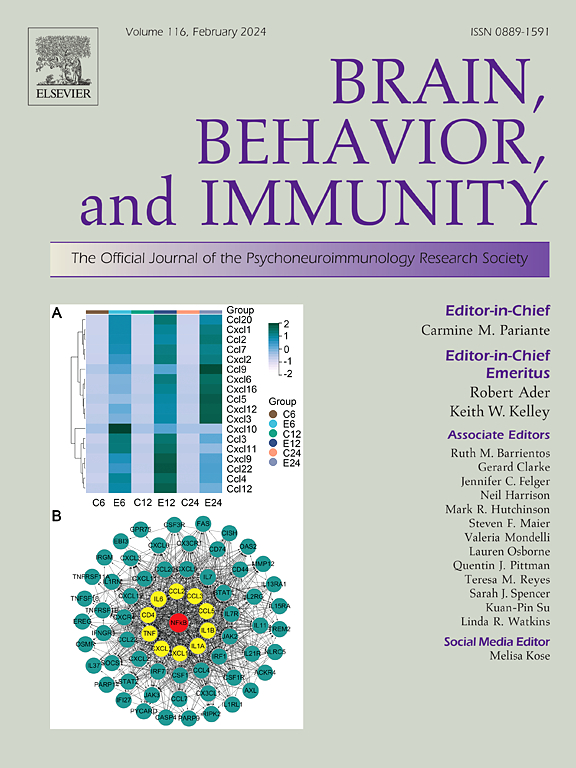血浆基质金属蛋白酶在早期精神病、焦虑和抑郁中的水平:来自ALSPAC队列的证据
IF 8.8
2区 医学
Q1 IMMUNOLOGY
引用次数: 0
摘要
背景:越来越多的证据支持基质金属蛋白酶(MMPs)在精神疾病中的作用。MMPs最初被认为是细胞外基质(ECM)的调节因子,其功能跨越多个过程,包括炎症、突触可塑性、神经元迁移和血脑屏障维持。金属蛋白酶组织抑制剂(TIMPs)是金属蛋白酶的主要调节因子。在本研究中,我们在雅芳父母和儿童纵向研究(ALSPAC)中检查了血浆MMPs和TIMPs与24 岁年轻人精神障碍的关系。方法:本研究是雅芳父母与儿童纵向研究中的一项巢式病例对照研究,包括374名符合精神障碍标准的参与者(35人符合精神障碍标准,201人符合轻度/中度抑郁症标准,266人符合广泛性焦虑症标准)和401名对照组。所有病例和对照组都是从4019名参与者中挑选出来的,这些参与者在24岁 岁时参加了研究,完成了精神评估并提供了血浆样本。MMP2、MMP3、MMP9和TIMP-4的血浆浓度采用Olink®Cardiovascular Panel III上提供的接近扩展测定法进行定量。Logistic回归分析比较了病例和对照组的标准化MMPs和TIMPs水平。模型根据性别、体重指数和吸烟情况进行了调整。结果:有证据表明MMP3与抑郁症之间存在关联(优势比[OR] 1.35, 95 %可信区间[CI] 1.06-1.73)。有证据表明TIMP4与抑郁症(OR 1.51, 95 % CI 1.22-1.88)和广泛性焦虑症(OR 1.43, 95 % CI 1.19-1.72)之间存在关联。没有证据表明MMPs和精神障碍之间存在关联。结论:研究显示,与对照组相比,24岁的抑郁症和焦虑症患者血浆中TIMP-4浓度升高。有证据表明MMP3和抑郁症之间存在关联。这些发现进一步支持金属蛋白酶作为生物标志物参与成年早期精神障碍的病理生理。本文章由计算机程序翻译,如有差异,请以英文原文为准。
Plasma levels of matrix metalloproteinases in early psychosis, anxiety and depression: Evidence from the ALSPAC cohort
Background
Converging evidence supports the role of Matrix Metalloproteinases (MMPs) in psychiatric disorders. Originally identified as regulators of the extracellular matrix (ECM), MMPs’ functions span multiple processes, including inflammation, synaptic plasticity, neuronal migration, and blood–brain barrier maintenance. Tissue Inhibitors of Metalloproteinases (TIMPs) are major regulators of MMPs. In the present study we examined the associations of plasma MMPs and TIMPs with mental disorders in young adults aged 24 years in the Avon Longitudinal Study of Parents and Children (ALSPAC).
Methods
The present study was a nested case control study within the Avon Longitudinal Study of Parents and Children and comprised 374 participants who met criteria for psychiatric disorders (35 met the criteria for psychotic disorder, 201 for mild/moderate depressive disorder, and 266 for generalised anxiety disorder) and 401 controls. All cases and controls had were selected from the group of 4019 participants who had attended at age 24 years, completed psychiatric assessments and provided plasma samples. Plasma concentrations of MMP2, MMP3, MMP9 and TIMP-4 were quantified using proximity extension assays available on Olink® Cardiovascular Panel III. Logistic regression analysis compared standardised MMPs and TIMPs levels in cases and controls. Models were adjusted for sex, body mass index, and cigarette smoking.
Results
There was evidence for an association between MMP3 and depressive disorder (Odds ratio [OR] 1.35, 95 % confidence interval [CI] 1.06–1.73). There was evidence for an association between TIMP4 and depressive disorder (OR 1.51, 95 % CI 1.22–1.88) and generalised anxiety disorder (OR 1.43, 95 % CI 1.19–1.72). There was no evidence for an association between MMPs and psychotic disorders.
Conclusions
The study revealed that 24-year-olds with depressive and anxiety disorders exhibited elevated plasma concentrations of TIMP-4 compared to controls. There was evidence for an association between MMP3 and depressive disorder. These findings provide further support for the involvement of metalloproteinases as biomarkers in the pathophysiology of mental disorders during early adulthood.
求助全文
通过发布文献求助,成功后即可免费获取论文全文。
去求助
来源期刊
CiteScore
29.60
自引率
2.00%
发文量
290
审稿时长
28 days
期刊介绍:
Established in 1987, Brain, Behavior, and Immunity proudly serves as the official journal of the Psychoneuroimmunology Research Society (PNIRS). This pioneering journal is dedicated to publishing peer-reviewed basic, experimental, and clinical studies that explore the intricate interactions among behavioral, neural, endocrine, and immune systems in both humans and animals.
As an international and interdisciplinary platform, Brain, Behavior, and Immunity focuses on original research spanning neuroscience, immunology, integrative physiology, behavioral biology, psychiatry, psychology, and clinical medicine. The journal is inclusive of research conducted at various levels, including molecular, cellular, social, and whole organism perspectives. With a commitment to efficiency, the journal facilitates online submission and review, ensuring timely publication of experimental results. Manuscripts typically undergo peer review and are returned to authors within 30 days of submission. It's worth noting that Brain, Behavior, and Immunity, published eight times a year, does not impose submission fees or page charges, fostering an open and accessible platform for scientific discourse.

 求助内容:
求助内容: 应助结果提醒方式:
应助结果提醒方式:


